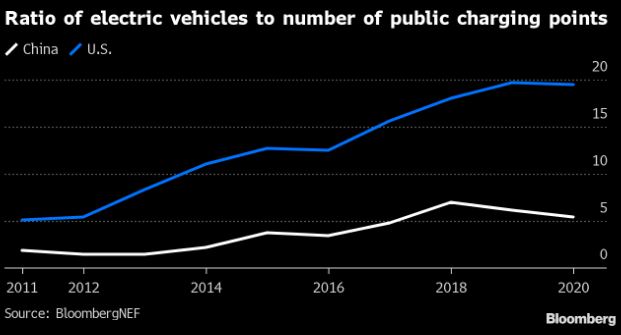Colin McKerracher
Head of Advanced Transport
BloombergNEF
At the beginning of each year at BloombergNEF — Bloomberg’s clean energy and transport research group — my team and I do a comprehensive update of all our data sets, tracking how the move to electric vehicles is shaping up around the world. We’ve been doing this for over a decade now, and that vantage point highlights some significant developments. One of those is on EV charging points, and the latest updates show some stark differences in how fast countries are tackling one of the last remaining barriers to widespread EV adoption.
The most remarkable thing is just how fast China is pulling ahead on this front. China had over 800,000 EV charging outlets available for public use installed at the end of 2020, up from 516,000 in 2019 and 300,000 in 2018. In December 2020 alone, China installed 112,000 public charging points — more than the entire U.S. public charging network.

It is worth noting that December was an extraordinary month. A deeper look at the data shows that October was the next highest month for charger installations, with 63,000, and other months were much lower. So we should be careful about extrapolating from the December numbers alone. Still, at the end of 2020 China represented almost two-thirds of all public charging points installed globally.
A key point here is that China likely also needs more public charging infrastructure than, say, parts of Europe or the U.S. The U.S. has a lot of detached homes with driveways or garages that provide easy home charging options, reducing the amount of public chargers that drivers will need to feel comfortable making the jump to electric. China’s EV owners so far are mostly high-rise dwellers in cities with strong policies and incentives aimed at limiting sales of new internal combustion vehicles. China has another 900,000 home and workplace charging points installed, while the U.S. has tens of millions of garages with a socket.
China also is building ahead of demand, and preparing for much higher levels of EV adoption. The ratio between the number of public charging points and the size of the EV fleet is much lower in China and has improved steadily for the last few years, even as EV sales took off.
The ratio improved in the U.S. in 2020, but only slightly. There is now one charging point for about every 20 EVs in the U.S., while for China it is around one to five. Teasing out causality is difficult here, but if you squint at the data across multiple countries you can see a trend where the more EVs that are sold, the more money that goes into installing charging stations and poles. Eventually, a robust public charging network will be necessary everywhere to spread out EV adoption across all income levels and housing types. While the move to electric vehicles is now inevitable, it may not be equitable.

Of course, individual charging outlets isn’t the only measure that matters. Power output, location, quality of user interface and payment system, utilization rates, and other factors also are important. During Volkswagen’sPower Day last week, executives from the German automaker highlighted that only 30% of public chargers in some parts of China are functional — due either to defective chargers or the spaces being blocked by internal combustion engine vehicles. Quality clearly trumps quantity here. This was a key factor in VW allocating almost $500 million towards building new fast chargers in Europe and China to support the company’s planned EV rollout.
Each week, I’ll be digging into the data from around the world on the move to electric vehicles and other developments shaping the way we move. Sharing new BNEF datasets and analysis, I’ll help to shed more light on the road ahead.
Colin McKerracher manages coverage of the transport and auto sector at BloombergNEF. His global team of analysts track the technology, policy and economic factors shaping the future of how people and goods move. Colin writes weekly for Hyperdrive on the future of electric transportation.






